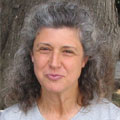 Adios Punta Arenas
Adios Punta Arenas
ABOARD THE RVIB N. B. PALMER, ON THE SOUTHERN OCEAN-- Adios Punta Arenas, Chile. Hello Research Vessel and Ice Breaker, Nathaniel B. Palmer. We, the crew, support staff and scientists of the NBP Iceberg Cruise III, left port in Punta Arenas on March 6th to begin our 40-day cruise... {Read More »}

 Maria Vernet is a marine scientist from Scripps Institution of Oceanography at the University of California, San Diego. She has participated in various studies involving phytoplankton ecology and physiology including the effects of ultraviolet radiation on photosynthesis to the grazing by Antarctic krill on coastal phytoplankton. During
Maria Vernet is a marine scientist from Scripps Institution of Oceanography at the University of California, San Diego. She has participated in various studies involving phytoplankton ecology and physiology including the effects of ultraviolet radiation on photosynthesis to the grazing by Antarctic krill on coastal phytoplankton. During 







